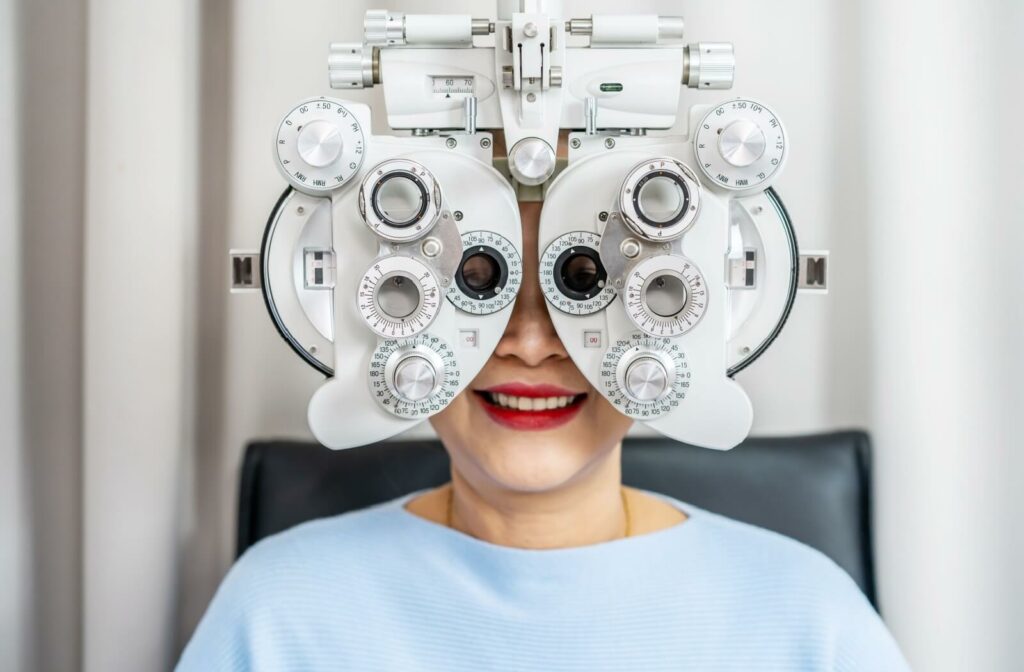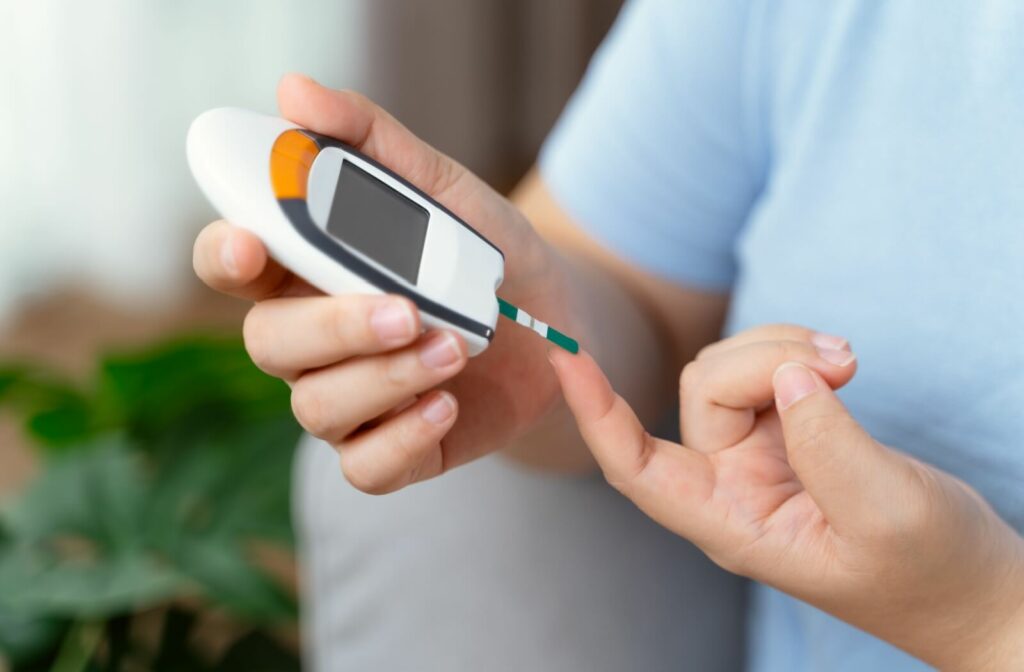Did you know that diabetes can affect your eye health? Diabetes is a condition that affects your blood sugar levels and blood vessels, and the tiny blood vessels in your eyes are no exception.
We (and the Canadian Association of Optometrists) recommend people with diabetes visit their optometrist for a diabetic eye exam at least once a year. Booking an annual eye exam is a proactive way to safeguard your health. In the meantime, keep reading to learn about the relationship between diabetes and eye diseases.
Diabetes & Eye Health
Diabetes is a condition that affects insulin production. Insulin is a hormone that regulates blood sugar levels, and people with diabetes either cannot produce it on their own or they can’t use their insulin effectively.
There are 3 main types of diabetes:
- Type 1: This type of diabetes is an autoimmune disorder that affects about 5-10% of people with diabetes. It tends to develop in adolescence, though adult onset is possible. People with type 1 diabetes can’t make insulin or regulate their blood sugar, so they have to inject insulin or use an insulin pump.
- Type 2: This type of diabetes affects 90-95% of people with diabetes. It often starts in adulthood, but it can begin in childhood, too. People with type 2 diabetes either don’t produce enough insulin or they can’t properly use the insulin their body’s produce. It’s possible to manage type 2 diabetes with lifestyle changes, but medical intervention is sometimes necessary. People at risk of developing type 2 diabetes are said to have prediabetes.
- Gestational diabetes: This type of diabetes is usually temporary and affects people during pregnancy.
If you have diabetes, you are far from alone. According to Diabetes Canada, someone is diagnosed with diabetes every 3 minutes.
Eye Diseases Associated With Diabetes
High blood sugar levels can affect your eye health. Eye diseases associated with diabetes include impaired vision (eg. blurry or double vision), changes in eyewear prescription, early onset of age-related farsightedness (presbyopia), early onset of cataracts, and reduced corneal sensitivity. Other conditions related to diabetes include:
- Diabetic retinopathy: A complication of diabetes, diabetic retinopathy affects the retina. Located at the back of your eye, your retina contains cells that convert light into nerve signals, which are then interpreted by the brain. Diabetic retinopathy can cause bleeding, swelling, and abnormal blood vessel growth, and it’s a major cause of vision loss in Canada.
- Diabetic macular edema: Diabetic retinopathy can cause diabetic macular edema (DME). Macular edema is characterized by swelling in the retina, and symptoms include blurry vision, dim colours, wavy-looking objects, and objects that may seem different sizes in each eye.
- Retinal detachment: This is when the retina is either completely or partially separated from the back of the eye. Retinal detachment can lead to partial or total vision loss. If you’re diagnosed with retinal detachment, your optometrist will refer you to an ophthalmologist for surgery.
- Glaucoma: This disease affects your optic nerve and can lead to vision loss. Glaucoma is often called the “silent thief of sight” because it often shows few symptoms in its early stages.

Importance of Regular Eye Exams
The truth is, many eye conditions don’t show noticeable symptoms until they’ve advanced to a stage that’s more difficult to treat. That’s why eye exams are so important: they can screen for diseases you may otherwise miss. Eye exams can even detect systemic health issues like cardiovascular disease and even some types of cancer.
Diabetic Eye Exams: What to Expect
Most adults are advised to schedule an eye exam every other year. However, yearly eye exams are recommended for some individuals, including people with diabetes.
During a diabetic eye exam, your optometrist may perform a dilated eye exam. This involves applying eyedrops to your eyes, which can sting a little. These eye drops make your pupils larger (dilated). Dilation can take 20 to 30 minutes.
Your optometrist will then examine your eyes using equipment that can see the back of your eye, giving them insight into your eye health. Dilation is a simple procedure, but you may experience blurry vision, trouble focusing, and light sensitivity.
It’s a good idea to arrange for transportation home after the appointment so you don’t have to drive. You may also want to bring sunglasses to help keep you comfortable when you leave the clinic.
Signs & Symptoms of Eye Disease
Regular eye exams are an opportunity to screen for diseases you may otherwise miss. However, if you notice changes in your vision, you should consult with an optometrist as soon as possible. The following signs and symptoms mean you should book an appointment with us right away:
- Change in iris colour
- Crossed eyes
- Dark spots in the centre of your vision
- Double vision
- Dry eyes
- Cloudy vision
- Eye pain
- Floaters or flashers
- Halos (circles around lights)
- Loss of vision
- Light sensitivity
Get Ahead of Your Next Eye Exam
Regular eye exams are important for everyone, including children, adults, older adults, and people with diabetes. Even if you have healthy vision, you should visit your optometrist regularly to screen for diseases that show few noticeable symptoms in their early stages. Early detection means early intervention.
Total Focus Optometry has been providing eye care services to our community for over 70 years. We look forward to getting to know you and your visual needs. Book your next eye exam with us today.




